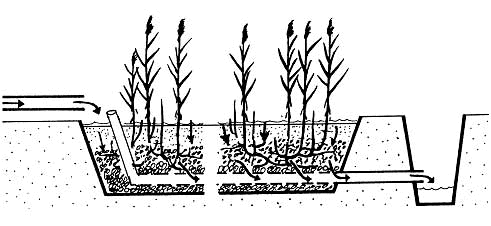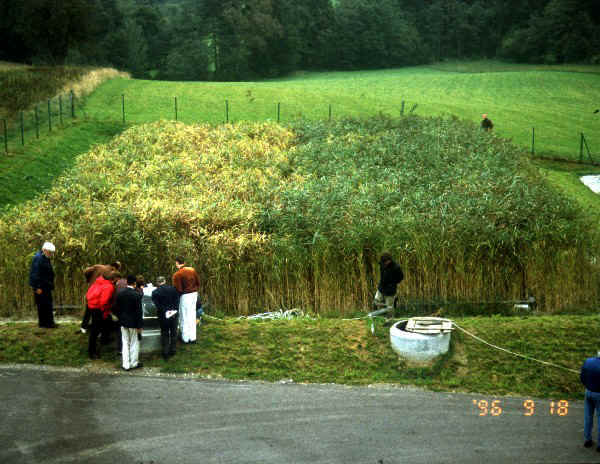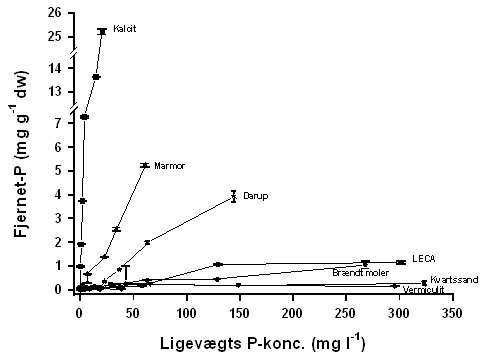|
Beplantede filteranlæg til rensning af spildevand i det åbne land Summary and conclusionsProject background and objectivesNew legislation requires that sewage produced in rural areas be treated adequately in order to improve the environmental conditions in stream and lakes. Single houses and other sewage producers in areas without a sewer system must improve their sewage treatment during the next couple of years. The preferred disposal solution in rural areas in Denmark is soakaways (soil infiltration). But at many sites it is not possible to use soakaways because of clayish soil conditions or high water tables. There is therefore a need to find new and effective on-site technologies. The objective of the study is to establish new knowledge on ‘green’ technologies that can be used for on-site sewage treatment in rural areas. Green technologies are here defined as systems where plants contribute to the treatment process and where the use of resources (energy) is low. Root zone treatment systems are according to this definition a green technology. But root zone systems do not meet the treatment demands established in the new legislation. Focus of the study has therefore been on subsurface flow constructed wetland systems with vertical flow. The treatment performance of vertical flow systems is more efficient than that of horizontal flow systems.
Sketch of a subsurface flow constructed wetland system with vertical flow. The sewage must be pre-treated in a sedimentation tank before discharge to the wetland system. Methods Several European countries (Austria, Germany and England) have produced guidelines for the construction of subsurface flow constructed wetland systems. These and other relevant sources of literature are summarised in the report. In addition, field studies have been carried out in a five-year old vertical constructed wetland system in order to study nitrification ability. Furthermore, a series of laboratory experiments have been conducted to evaluate the phosphorus binding capacity of different natural filter sands as well as artificial materials that might be used to enhance phosphorus-binding capacities of the wetland media. Main conclusions Subsurface flow constructed wetland systems with vertical non-saturated flow will be able to fulfil the most stringent treatment requirements imposed for on-site treatment in rural areas, i.e. 95% reduction of BOD5, 90% reduction of total-phosphorus, and 90% nitrification. However, area demand is not as yet fully established, and more work is needed to refine the removal process for phosphorus. The guidelines produced in other European countries cannot be directly transferred to Denmark because these do not generally include so stringent effluent demands. The study has established a set of provisional guidelines that can be used until more detailed guidelines are produced. To summarize:
An experimental constructed wetland system with vertical flow should be constructed for the purpose of evaluating the unresolved or poorly resolved questions particularly in relation to area dimensioning and to the design and construction of the phosphorus filter unit. In addition, a number of full-scale single household systems should be constructed and monitored.
Vertical-flow constructed wetland system in Austria. The system contains two beds operating in parallel (Foto: H. Brix) ResultsEuropean guidelines The German guidelines concern on-site constructed wetland systems up to 50 PE and municipal systems up to 1000 PE. The guidelines are only valid for removal of organic matter (outlet criteria: BOD5 < 40 mg/l; COD < 150 mg/l). Austrian guidelines include nitrification (NH4-N < 10 mg/l) but not removal of phosphorus. English guidelines only describe constructed wetland systems with subsurface horizontal flow. Hence, these guidelines cannot be directly transferred to Danish conditions with more stringent outlet requirements. . Field studies Experiments have been conducted to evaluate the nitrification activity in vertical flow systems as a function of area mass loading rate, loading frequency and temperature of treated, but not nitrified, effluent. The constructed wetland system used as basis for the experiments was, however, poorly suited for these experiments because of the restricted bed depth and other on-site problems with system design and wastewater composition. It was therefore not possible to establish the relationship between area loading rate and nitrification activity. The studies do, however, indicate that frequent pulse loadings increase the nitrification rate. Furthermore, nitrification occurred even at 2° C. Thus, a pulse loaded vertical filter can sustain some nitrification activity even at very low water temperatures. Recycling of nitrified effluent water to the sedimentation tank increases the removal of total-nitrogen because of denitrification. Phosphorus binding capacities of natural sands In subsurface flow constructed wetland systems phosphorus is mainly removed by sorption to the bed substrate. Sands from different gravel pits have very different binding capacities. The study shows that particularly the content of calcium is of importance for the phosphorus binding capacity. Sands with a high content of calcium have a higher binding capacity compared to sands with a low content of calcium. Furthermore, the texture of the sand is of importance. Fine-textured sand has a higher binding capacity than coarse-grained gravel. For some sands the phosphorus binding capacity will be used up after only a few months in a constructed wetland system, whereas for others the performance will be sustained for several years. When selecting sand to be used as the medium in a subsurface flow constructed wetland system, it is of prime importance to secure the right texture in order to obtain a high hydraulic conductivity. And in order to maximise removal of phosphorus, the content of calcium should be high. Phosphorus binding capacities of selected artificial materials It might be necessary to amend the bed substrate with a material with high phosphorus binding capacity in order to enhance and sustain phosphorus removal. Especially calcium containing materials, calcite and crushed marble, were shown to have high phosphorus binding capacities. Burnt diatomaceous earth also had a high binding capacity, but required longer contact time. Light Expanded Clay Aggregates (LECA) and vermiculite did not bind phosphorus efficiently. Particularly calcite seems to be well suited for use as a bed amendment to enhance phosphorus removal. However, calcite might also be used in a separate filter unit for phosphorus removal. When saturated with phosphorus, the filter content (calcite) can be exchanged.
Phosphorus binding isotherms for different natural sands (Darup and quarts sand) and some artificial materials (granulated calcite, crushed marble, LECA, burnt diatomaceous earth, and granulated vermiculite).
|


